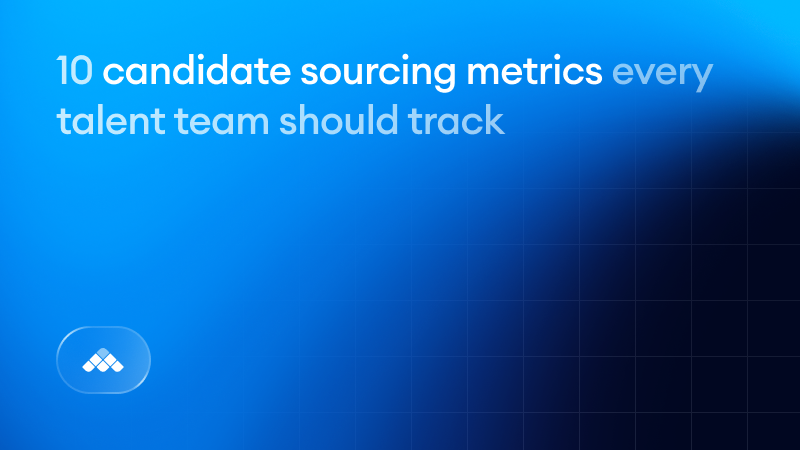Every recruiter wants to fill roles faster. But speed alone doesn’t tell the full story. Sourcing success depends on understanding how and why candidates move through your funnel, from the first message to the signed offer.
The only way to see that clearly is through data. By tracking the right sourcing metrics, talent teams can pinpoint what’s working, identify bottlenecks, and build sourcing engines that continuously improve.
This guide breaks down the most interesting candidate sourcing metrics to monitor, and how to use automation and AI to hit your goals faster.
3 key takeaways
- Sourcing metrics give talent teams the visibility they need to make hiring faster, fairer, and more predictable.
- Tracking performance data helps recruiters optimize sourcing channels, messaging, and conversion rates.
- With AI-powered automation, recruiters can spend less time reporting and more time building strong pipelines.
What are sourcing metrics?
Sourcing metrics are the measurable indicators that show how effective your recruiting team is at identifying, engaging, and converting talent. They track every stage of the sourcing funnel, from how quickly you start a search to how long it takes to close a role.
For example:
- A high outreach response rate means your messaging resonates with candidates.
- A short time to launch shows your sourcing process is efficient.
- A low cost per hire indicates your sourcing channels are delivering good ROI.
The right sourcing metrics give you a complete view of sourcing performance, turning recruiting into a data-driven function that can scale intelligently.
10 key sourcing metrics to monitor
Monitoring sourcing metrics gives talent teams a clear view into performance, efficiency, and return on effort. By analyzing trends, you can forecast hiring needs more accurately, strengthen conversion rates, and continuously optimize your sourcing strategy for greater impact.
Each metric below helps measure a different part of your sourcing process, from speed and quality to engagement and hiring ROI.
1. Time to launch
- What it measures: The time it takes to begin sourcing after a new role is approved.
- Why it matters: Long delays before sourcing starts can push hiring timelines weeks behind schedule. Efficient teams launch searches quickly by using standardized templates, AI sourcing tools, and prebuilt candidate pools.
- Goal: Keep this number as low as possible by automating setup and maintaining a steady flow of ready-to-engage candidates.
2. Outreach response rate
- What it measures: The percentage of candidates who respond to your outreach messages.
- Why it matters: A low response rate indicates your messaging or targeting needs work. Strong personalization and timely follow-ups can double engagement.
- Goal: Use analytics to A/B test subject lines or message styles, and track which tone or format delivers better results.
3. Application-to-interview conversion rate
- What it measures: The percentage of sourced candidates who move from application to interview stage.
- Why it matters: This reveals the quality of your sourcing. If most sourced candidates aren’t making it to interviews, you may be targeting the wrong skills or experience levels.
- Goal: Strong teams aim for 30–50% conversion from application to interview for sourced candidates.
4. Quality of hires by channel
- What it measures: The performance or retention rate of hires from different sourcing channels.
- Why it matters: Not all channels produce equally strong hires. Comparing performance by source helps allocate time and budget to what works best — whether that’s referrals, LinkedIn, or your talent community.
- Example: You may discover that referred candidates stay twice as long as job board hires, justifying more investment in referral programs.
5. Offer acceptance rate
- What it measures: The percentage of candidates who accept your job offers.
- Why it matters: A low offer acceptance rate can point to issues with compensation, communication, or candidate experience.
- Goal: Keep improving over time. High-performing teams close 85–90% of offers, because they engage candidates well throughout the funnel.
6. Time to fill
- What it measures: The total time from role opening to accepted offer.
- Why it matters: Time to fill is one of the most universally valuable recruiting KPIs. Tracking it specifically for sourced candidates helps you see whether sourcing efficiency is improving or slowing down.
- Goal: Automate early-stage tasks like resume screening and interview scheduling. Aim to cut days or weeks from this metric.
7. Pipeline speed
- What it measures: How quickly candidates move through each stage of the sourcing and interview process.
- Why it matters: Stalled candidates are a red flag for inefficiency.
- Goal: Use recruitment analytics to find where candidates linger—in outreach, screening, or feedback—and implement sourcing automation to accelerate handoffs.
8. Cost per hire
- What it measures: The average cost to fill a role, including job board fees, recruiter time, and software.
- Why it matters: Cost per hire is a clear measure of sourcing ROI. If costs rise without improving quality, you may need to rebalance sourcing efforts or adopt automation.
- Goal: Lower cost per hire without sacrificing candidate quality. This is often achieved through efficient sourcing workflows and better uses of data.
9. Candidate satisfaction score (CSAT)
- What it measures: How satisfied sourced candidates are with your process.
- Why it matters: Candidate experience impacts your brand reputation and offer acceptance rates.
- Goal: Send automated post-process surveys to gather CSAT data without extra effort. Then use this specific feedback to refine communication and speed.
10. Sourcing channel efficiency
- What it measures: The ratio of successful hires to total candidates sourced from each channel.
- Why it matters: It reveals where your best candidates come from, so you can optimize sourcing mix and reduce wasted effort.
- Goal: Use analytics dashboards in tools like Gem or Ashby to compare channels over time.
How AI and automation help improve these metrics
AI and automation have transformed how recruiting teams measure and optimize sourcing. Instead of manually tracking spreadsheets or logging notes, modern recruiting platforms gather data automatically at every stage.
AI helps by:
- Automating sourcing tasks: find and rank candidates based on skills and job descriptions.
- Analyzing outreach performance: show which messages get the best responses.
- Tracking candidate progress: highlight bottlenecks and predict drop-off risks.
- Reporting results in real time: provide leaders with dashboards instead of static reports.
Recruiters who use AI hiring tools spend less time chasing data, and more time acting on insights.
How Metaview helps
Metaview turns interviews—one of recruiting’s richest but least-measured stages—into structured, actionable data that feeds your sourcing strategy.

With Metaview, talent teams can:
- Track feedback times and interview-to-offer conversion automatically.
- Identify which sourced candidates tend to perform best in interviews.
- Get AI-generated interview summaries that improve feedback speed and candidate experience.
- Combine interview data with sourcing analytics to pinpoint where the best hires come from.
By pairing sourcing metrics with interview intelligence, Metaview helps teams not only find talent faster, but also understand what makes a great hire.
Measure and master your sourcing process effectively
The best recruiting teams don’t just source candidates, they measure, analyze, and continuously improve. By tracking these key sourcing metrics, you’ll uncover exactly where to focus your time, automate repetitive work, and elevate the entire hiring process.
And data isn’t here to replace recruiter intuition, but to enhance it. With the right technology, every sourcing decision becomes smarter, faster, and more effective.
Ready to track and improve your sourcing metrics? Try Metaview for free and turn every conversation into measurable progress.

Sourcing metrics FAQs
1.How do I know which sourcing metrics to prioritize?
Start with the metrics most connected to your goals. If your team struggles with hiring pipeline volume, focus on time to launch and outreach response rates. If your concern is candidate quality, track conversion rates and quality of hire by channel.
Over time, you can expand to include metrics like cost-per-hire and candidate satisfaction for a broader perspective.
2. What’s a good outreach response rate for recruiters?
It varies by role and industry, but a good response rate typically falls between 25–40% for sourced candidates. Highly personalized outreach and strong employer branding can push that number even higher.
Track response rates per recruiter or per channel. It’s often the best indicator of how engaging your team’s outreach really is.
3. How can I measure the quality of hires from sourcing?
Quality of hire combines data from sourcing, interviewing, and onboarding. You can measure it by tracking metrics like performance ratings, retention after six months, or manager satisfaction.
Over time, compare this data by sourcing channel. For example, seeing whether hires from referrals outperform job board hires in performance or tenure.
4. What tools help track sourcing metrics automatically?
Most Applicant Tracking Systems (ATS) and Candidate Relationship Management (CRM) tools now include sourcing analytics dashboards. These platforms provide real-time visibility into conversion rates, outreach performance, and source-of-hire data.
For deeper insight into interview and feedback metrics, Metaview integrates with your ATS to capture and analyze interview outcomes automatically.
5. How can AI improve sourcing metrics?
AI improves sourcing metrics by automating and optimizing key stages in the funnel:
- Finding talent: AI sourcing tools continuously search across databases to identify qualified candidates.
- Improving outreach: AI analyzes message tone, timing, and personalization for higher engagement.
- Predicting outcomes: AI models can forecast which candidates are most likely to convert or accept offers.
This not only boosts performance but also helps recruiters make data-backed decisions without manual tracking.
6. What’s the best way to benchmark sourcing performance?
Benchmark against both industry standards and internal baselines. External benchmarks (e.g., average response rates or time-to-fill for your industry) show how you compare to peers. Internal benchmarks help track improvement over time, such as reducing time-to-launch by 20% quarter over quarter.
The goal isn’t perfection; it’s consistent, measurable progress.
7. How often should sourcing metrics be reviewed?
For active hiring teams, review sourcing metrics weekly or biweekly to catch issues early. For strategic planning, conduct a monthly or quarterly review to identify trends, reallocate budget, and forecast future needs.
Automated dashboards make it easy to track performance continuously without manual reporting.


